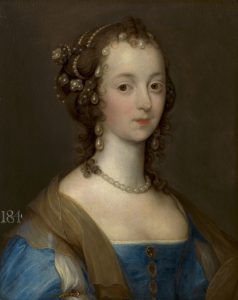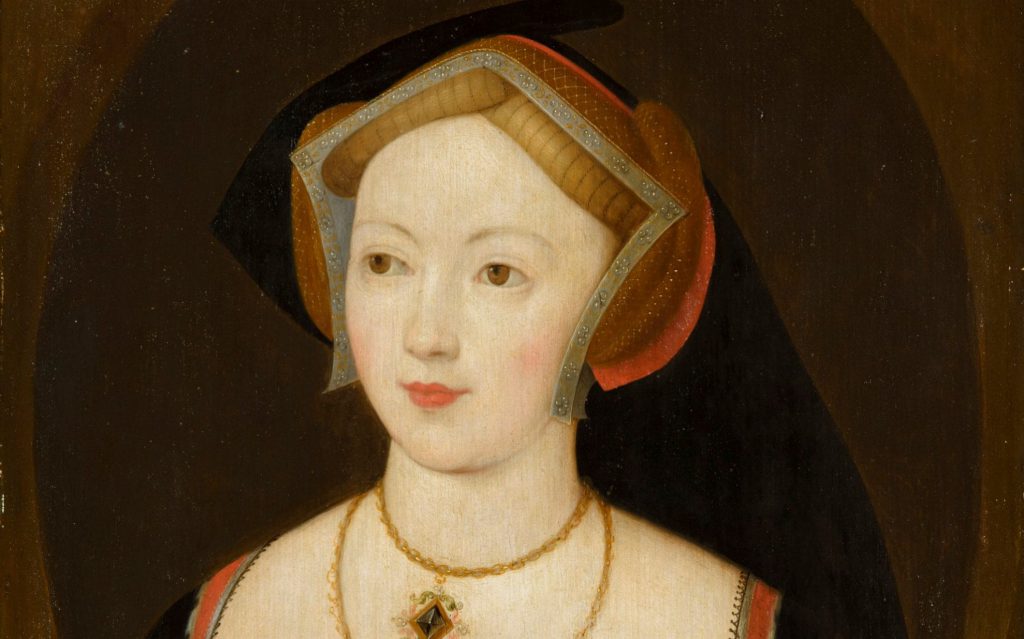It has been in the Royal Collection for hundreds of years, catalogued anonymously as a “Portrait of a Woman”, possibly copied from a lost picture by Hans Holbein, court painter to Henry VIII. Now its sitter has been identified as Mary Boleyn, the king’s beguiling mistress and sister of his beheaded second wife Anne.
The new research firmly links the picture to a set of 14 “Beauties” that decorated Queen Anne’s Bathing Room at Windsor Castle 300 years ago – only to be separated in the 19th century because it looked so different from the others.
Although the pictures were each painted in the 17th century and have similar gilt frames, this one seemed the odd-one-out because the sitter is in 16th-century dress. The other portraits are all 17th-century aristocrats – from a duchess to countesses, each possibly copied from original pictures by Royal painters of the day, Anthony Van Dyck and Sir Peter Lely, with one by Samuel Cooper, the miniature painter.
In the 19th century, the 13 portraits were eventually moved to Queen Victoria’s Drawing Room at Windsor, and more recently to Highgrove, the private residence of the Prince of Wales and the Duchess of Cornwall. The 14th portrait had been sent to Hampton Court in the 19th century and then, in 1995, to the Palace of Holyroodhouse in Edinburgh, where it hangs today in Mary, Queen of Scots’ bedroom.

Attributed to Remigius van Leemput (d. 1675), Portrait of a Woman, now identified as Mary Boleyn, oil on oak panel, 39.4 x 31.2 cm, Royal Collection Trust / © Her Majesty Queen Elizabeth II 2020
Now new evidence has emerged through dendrochronology tests, dating the picture’s wood and determining its origin, as well as investigations into the paintings’ provenance and comparative analysis. Seventeenth-century inscriptions on two other paintings in private British collections offered further proof of the sitters’ identities.
To the astonishment of art historians, the wood of the 14th portrait matched another portrait in the set which, in turn, was found to have a direct link to Mary Boleyn in being identified as Lady Herbert, who married her great-grandson.
The discoveries have been made by The Jordaens Van Dyck Panel Paintings Project (JVDPPP), which is based in the Royal Museums of Fine Arts in Brussels and focusses on the Flemish masters Van Dyck and Jacques Jordaens.
Desmond Shawe-Taylor, Surveyor of the Queen’s Pictures, told the Sunday Telegraph: “It’s absolutely fascinating. We don’t have the resources to apply technical examination like dendrochronology to the whole collection, which is 7,000 paintings, so it’s wonderful to collaborate with the JVDPPP to help us in that way. One of the things that I’m endlessly trying to do is to group the paintings properly to sort out their history and their relationship to each other.
“When a stray is reunited with the family, there’s joy in heaven. It disproportionately increases the value and understanding of the whole group.”
Describing the paintings as “absolutely beautiful”, he said that the set could now be reunited.
Justin Davies, a British art historian and JVDPPP co-founder, said of the research: “It’s been a voyage of discovery. The results were remarkable and unexpected. Six of the 14 panels had been made from the same oak tree. The tree had started growing in south-west Germany before 1393 and was cut down between 1651 and 1671. In itself, this result constitutes a world record – six panel paintings from the same tree had not been recorded before.”

Attributed to Remigius van Leemput (d. 1675), Portrait of a Lady, now identified as Margaret Smith, Mrs Thomas Carey, later Lady Herbert (? d. 1678), oil on panel, 39.4 x 31.6 cm, RCIN 402537, Royal Collection Trust © Her Majesty Queen Elizabeth II 2020
He added: “The remaining eight pictures are four pairs of two in terms of their trees of origin. The Portrait of a Woman in 16th-century dress was an exact match for the only unidentified lady in the 13, the Portrait of a Lady in 17th-century dress. The two panels were made from an oak tree which grew in the Baltic region from the middle ages until it was cut down after 1629.”
All 14 of the paintings are thought to be by Remigius van Leemput, a Flemish artist who came to London in the 1630s, working in the studio of Van Dyck, whose paintings he specialised in copying.
Mr Davies said: “Van Leemput was an incredibly talented painter. Charles I hung his copies in his palaces. Van Leemput is right up there, at the top of his game. Painters of that era were absolutely delighted when their paintings were copied because it advertised their wares. Beauties were extremely fashionable… and Van Leemput’s are beautiful.”
They are all the more appreciated today because not all the original paintings from which they were copied have survived.
The 14 pictures are listed in an 18th-century inventory in the Royal Collection. Mr Shawe-Taylor said that the 14th picture was catalogued in the 19th century as a Holbein portrait of Anne Boleyn. By 1861, it had become “a portrait of a lady of the Court of Henry VIII”, he said. “So it’s been an anonymous person in Tudor costume until now.”
Mr Davies’s detective work took him to the Heinz Library and Archive at the National Portrait Gallery where he found photographs of two paintings in private British collections with crucial inscriptions proving that the 17th-century sitter was ‘Lady Herbert’ and the 16th-century one was Mary Boleyn.
Further research revealed that Lady Herbert was formerly Margaret Smith, who had married Thomas Carey, the great-grandson of Mary Boleyn. After his death in 1634, she married Sir Edward Herbert.
Mr Davies said of the “wonderful discoveries on these beautiful ladies”: “It’s reuniting a set and it’s identifying two in the set who’ve been unidentified for 300 years.”

